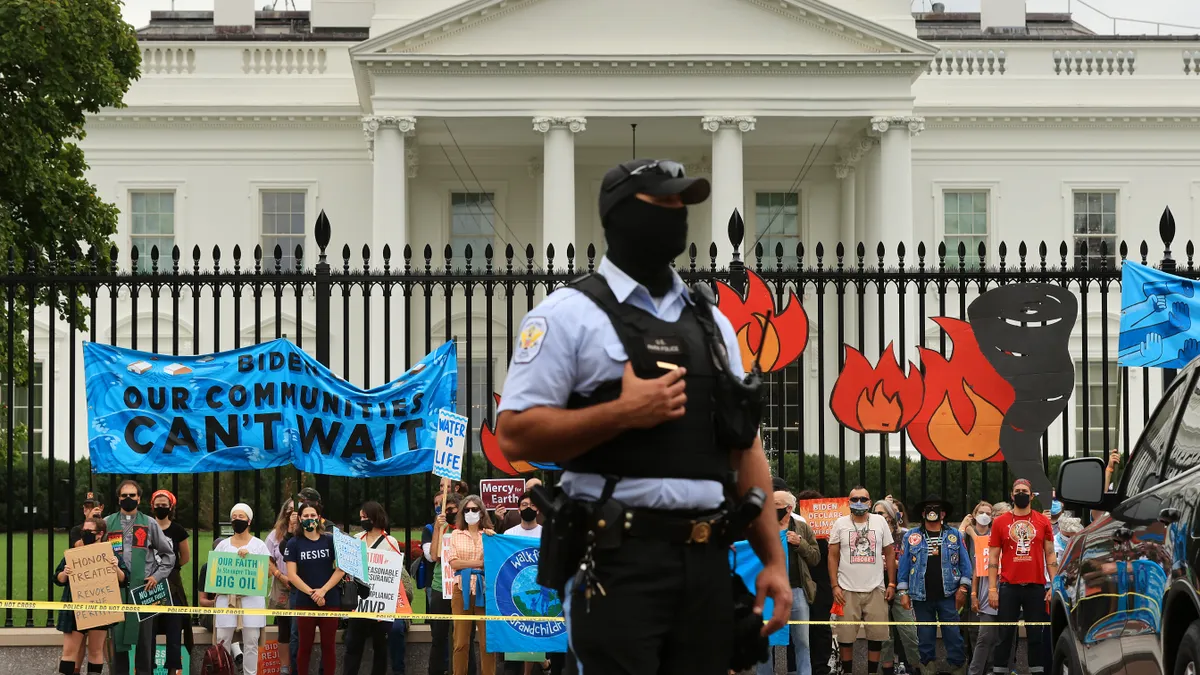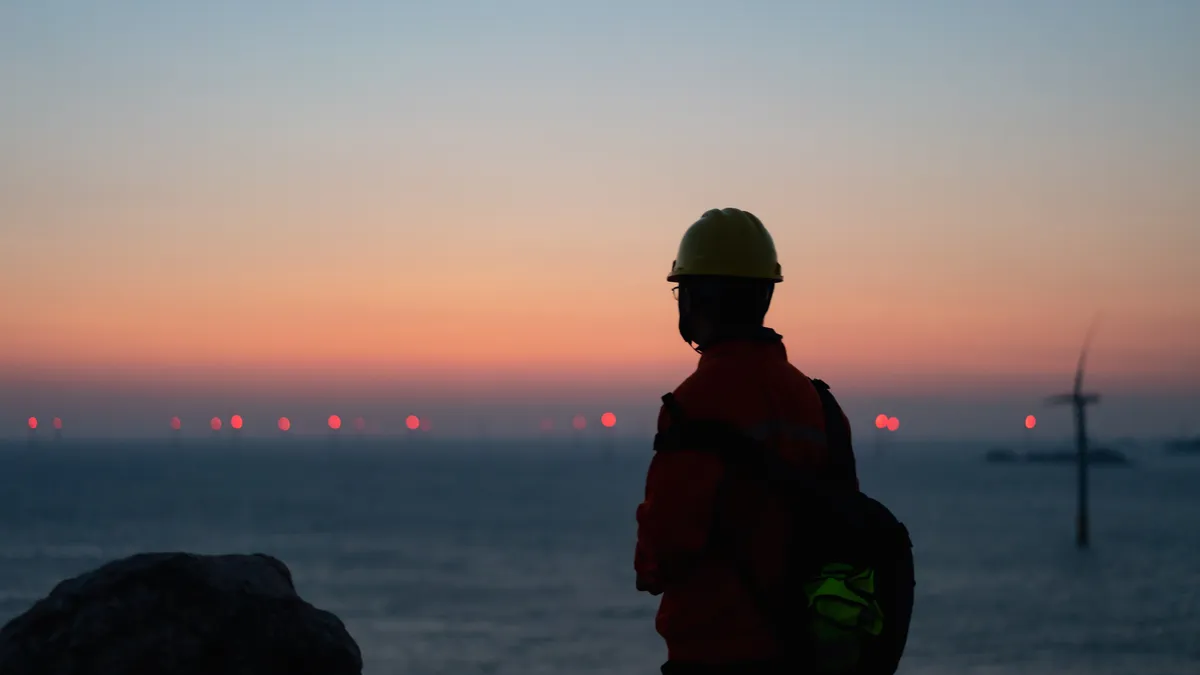As the Biden administration aims for a U.S. net-zero emissions economy by 2050 and works to deploy up to $1.6 trillion in climate and infrastructure funding, efforts to update the permitting process for renewables, transmission and other projects are catalyzing intense debates, sometimes between those typically allied on policy issues.
Clean energy groups generally support streamlining the permitting process to accelerate the deployment of renewables, storage and other resources and help mitigate the immediate effects of climate change. But many environmental groups oppose permitting reforms that could also benefit the fossil fuel industry, or weaken the National Environmental Policy Act.
“[NEPA] has been seen as a vanguard for environmental justice communities,” said Anthony Rogers-Wright, a racial and climate justice advocate who has worked for ICF International and the New York Lawyers for the Public Interest. “It doesn't even go far enough, but it's still seen as a first line of defense for cultural communities and indigenous communities as well. And to see that being tampered with now — it's like, for some, almost akin to tampering with Social Security.”
The high stakes of this conflict have “brought us to this phase where we're starting to see a lot of headbutting and a lot of lines being drawn, and philosophies and approaches that come with those respective lines,” he said.
From an environmental justice perspective, removing roadblocks to permitting and siting projects could endanger communities that are already burdened by pollution, advocates say.
“In some cases, we do want these analyses to be long. We don't want them to be rushed. We're talking about critical resources, and activities that require disturbing soil and disturbing landmasses,” said Rogers-Wright.
Costs, delays and uncertainty
Advocates for permitting reform, on the other hand, argue that the current demands placed on project developers can not only be burdensome but unhelpful to the communities they’re supposed to protect.
In a 2022 analysis, the Institute for Progress argued that NEPA in its current form “imposes massive costs on the federal government, drags clean energy projects out for years, and generates uncertainty that stops other projects from ever getting off the ground.”
Alec Stapp, a co-founder and co-CEO of IFP and one of the authors of that report, said he advocates for a “strong” permitting process that also offers certainty and efficiency.
“I think you could describe a strong permitting process as one that provides a quick and informed answer on whether a project has government approval to be built — a very swift and certain ‘yes’ or ‘no’ on whether you can build this project,” he said.
There's lots of [IRA and IIJA] investment. But there seems to be quite a lag in terms of actual real world deployment.

Alec Stapp
Co-CEO of the Institute for Progress
Stapp said that an efficient permitting process with imposed time limits would be “strong,” but “antithetical to what the environmental activism groups want, which is a tool that they can use to stop projects that they don't like.”
Those groups want it to be “easy to leverage [the permitting process] to stop bad projects that they don't want built at all,” he said — projects like “pipelines, new natural gas facilities, and export terminals.”
Stapp said he supports the use of categorical exclusions to the NEPA environmental review process — a category which the Environmental Protection Agency defines as “actions that a Federal agency has determined, after review by [the White House Council on Environmental Quality], do not individually or cumulatively have a significant effect on the human environment.”
In April, the CEQ finalized a rule to update the federal environmental review process under NEPA, including “new and more flexible methods for agencies to establish categorical exclusions to speed up low-impact projects” such as solar, electric vehicle charging infrastructure and transmission, the White House said in a release.
Earlier that week, the Department of Energy had issued a final rule establishing the Coordinated Interagency Transmission Authorization and Permits, or CITAP, program, which will make DOE the lead agency handling permits for new transmission projects.
Congress is also tackling permitting reform, with 10 bills introduced in this session alone, but the bills have struggled to advance despite bipartisan calls for action. Sens. Joe Manchin, I-W.Va., and John Barrasso, R-Wyo., announced May 21 that they would soon share a new draft of bipartisan permitting reform legislation with colleagues.
Manchin remarked that the Federal Energy Regulatory Commission’s recently-issued transmission planning and cost allocation reform rule was, “as my friend Senator Hickenlooper said … ‘a Band-Aid on Congress’s inaction.’”
Stapp said he wants to see reform that ends “the litigation doom loop that all kinds of projects are trapped in right now.” He noted his concerns about the uncertainty faced by project developers and their financiers, as well as lingering questions about the fate of the massive investments represented by the CHIPS Act, the Infrastructure Investment and Jobs Act and the Inflation Reduction Act.
“Is that money turning into steel in the ground?” he asked. “Are projects actually being built in the real world? Or are these just large dollar contracts that have been spent, but are now stuck in permitting purgatory? .... We by no means have final answers here, but we are starting to see some warning signs.”
Stapp added that the president himself “has been reported to be concerned that there’s not enough groundbreakings for new projects that are funded by the infrastructure bill or the IRA.”
“I share those concerns — like, where are the real projects?” he asked. “There's lots of investment. But there seems to be quite a lag in terms of actual real world deployment.”
Rogers-Wright said he thinks there is a political element to permitting reform supporters “on the liberal side of environmentalism ... because many of these people have staked their reputations” on the IRA with “very, very little time to show that it is actually beneficial and efficacious, because there's an election coming up in November.”
Community input and environmental justice
Denae King, an associate director and researcher at Texas Southern University’s Bullard Center for Environmental and Climate Justice, said permitting reform is a priority and the center is “really grateful” for the White House and EPA’s recent moves on the issue. However, thorough environmental reviews remain “extremely important,” she added.
“Oftentimes, in environmental justice communities, there are already several sources of industrial pollution, or sources of contaminants in air or water,” she said. “So really understanding cumulative impacts is becoming more and more important, and this permitting reform does that. I think the other thing that it does is promote meaningful public input.”
Community members are experts. They really have a good grasp on what's happening in their community, both in terms of their routes of exposure, and what kinds of health impacts they're seeing in their school, in their neighbors.

Denae King
Associate director at Texas Southern University’s Bullard Center for Environmental and Climate Justice
The new rule from the White House removed NEPA provisions that it says “created litigation risks and jeopardized community input” by “removing detailed and onerous requirements on what public comments must contain to be considered by agencies” and “removing provisions that attempted to curtail judicial review.”
King said that the public comment period for projects in development is often “short and not well advertised. So by the time [communities] actually get to have some input, it's not necessarily valued at that point…. After the developer has drawn a full map and already decided how the facility is going to be placed and located, it's a little too late to ask the community.”
That disadvantages both developers and communities, she said, as the former may end up sinking costs into an ultimately untenable project.
“Community members are experts,” King said. “They really have a good grasp on what's happening in their community, both in terms of their routes of exposure, and what kinds of health impacts they're seeing in their school, in their neighbors.”
Renewable project opposition
When it comes to the permitting of wind and solar projects, visual and noise complaints often drive community opposition, according to a May 22 report from the The Hamilton Project.
The report cites a 2023 paper from David Adelman, the Harry Reasoner Regents Chair at the University of Texas at Austin School of Law, which found that “litigation pressures against offshore wind [have] occurred in northeastern rural communities where residents place a high premium on protecting local landscape.”
“Other times, the renewable energy transition threatens existing local economies,” the report noted. “In Kentucky, coal is the most powerful political incumbent, in part because mining supports thousands of workers and their families each year.”
I think there is also just quite a bit of distrust out there over what the terms of permitting reform will be.

Chirag Lala
Director of energy policy at the Center for Public Enterprise
Chirag Lala, director of energy at the nonprofit Center for Public Enterprise, said he views the permitting reform issue as one of efficiency — making sure that community-level input flows upward in a way that lends itself to the best decision-making possible.
“The problem isn't stakeholder engagement,” Lala said. “And I do think there are some groups engaged in the permitting reform debate who either explicitly or border on suggesting that stakeholder engagement is the problem. It’s very much not.”
In an ideal world envisioned by CPE, Lala said there would be “a lot more” automatic permissions for projects, categorical exclusions, and “situations where public agencies are often in a privileged position to either gain the permitting and siting permissions that they need, or certainly to choose certain types of private projects that can get automatic or expedited permissions.”
“But, crucially, we don't see the fact that these communities need and want to raise certain concerns about how investment processes are going as itself the obstacle,” Lala said. He said existing permitting processes are what “is not servicing their needs in that respect.”
Lala suggested that issues such as environmental justice concerns, pollution cleanup and the employment of local workers can be addressed by policy mechanisms other than the permitting process itself.
“But I think there is also just quite a bit of distrust out there over what the terms of permitting reform will be, and where they will head from here,” Lala added.
Both Lala and Stapp suggested that “veto power” legal mechanisms like injunctions have the potential to threaten community benefit agreements reached between communities and developers, even when the “veto power” is being exercised by a third party like an environmental group.
In a process with no backstop authority, Lala said, “when different groups engage in that process, they do so knowing that just the very fact that they are filing a particular piece of paper, raising a particular objection, or attending a particular meeting could in and of itself create enough friction for a project not to go through.”
“Whereas if you have an entity that can intervene in the process at a certain point and just say, ‘Look, this is going through, everybody has said what they needed to say’, that changes certain actor incentives in that process,” he said.
Rogers-Wright, however, said he fears a shift to a more unilateral decision-making process would disenfranchise those who are directly impacted by those decisions.
“When you don't have a voice, when you're not a part of the process, you tend to be sacrificed,” he said. “If you speed the process up, that means you're going to be reducing [input] vastly — and that's already problematic, right? It’s not like so-called public participation is at an optimal level.”
Correction: We have updated this article to correct Anthony Rogers-Wright's title and role.























